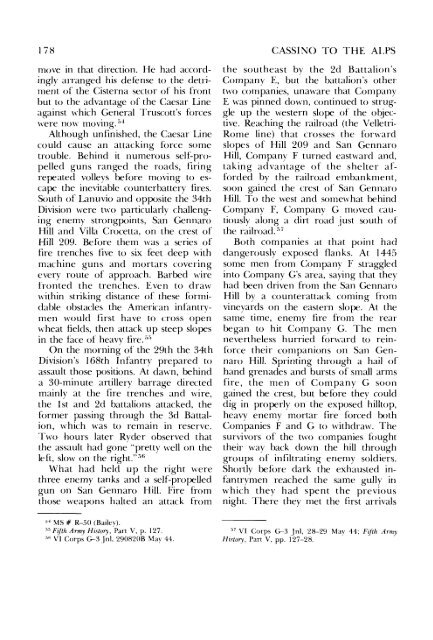Cassino to the Alps - US Army Center Of Military History
Cassino to the Alps - US Army Center Of Military History
Cassino to the Alps - US Army Center Of Military History
Create successful ePaper yourself
Turn your PDF publications into a flip-book with our unique Google optimized e-Paper software.
178<br />
move in that direction. He had accordingly<br />
arranged his defense <strong>to</strong> <strong>the</strong> detriment<br />
of <strong>the</strong> Cisterna sec<strong>to</strong>r of his front<br />
but <strong>to</strong> <strong>the</strong> advantage of <strong>the</strong> Caesar Line<br />
against which General Truscott's forces<br />
were now moving. 54<br />
Although unfinished, <strong>the</strong> Caesar Line<br />
could cause an attacking force some<br />
trouble. Behind it numerous self-propelled<br />
guns ranged <strong>the</strong> roads, firing<br />
repeated volleys before moving <strong>to</strong> escape<br />
<strong>the</strong> inevitable counterbattery fires.<br />
South of Lanuvio and opposite <strong>the</strong> 34th<br />
Division were two particularly challenging<br />
enemy strongpoints, San Gennaro<br />
Hill and Villa Crocetta, on <strong>the</strong> crest of<br />
Hill 209. Before <strong>the</strong>m was a series of<br />
fire trenches five <strong>to</strong> six feet deep with<br />
machine guns and mortars covering<br />
every route of approach. Barbed wire<br />
fronted <strong>the</strong> trenches. Even <strong>to</strong> draw<br />
within striking distance of <strong>the</strong>se formidable<br />
obstacles <strong>the</strong> American infantrymen<br />
would first have <strong>to</strong> cross open<br />
wheat fields, <strong>the</strong>n attack up steep slopes<br />
in <strong>the</strong> face of heavy fire. 55<br />
On <strong>the</strong> morning of <strong>the</strong> 29th <strong>the</strong> 34th<br />
Division's 168th Infantry prepared <strong>to</strong><br />
assault those positions. At dawn, behind<br />
a 30-minute artillery barrage directed<br />
mainly at <strong>the</strong> fire trenches and wire,<br />
<strong>the</strong> I st and 2d battalions attacked, <strong>the</strong><br />
former passing through <strong>the</strong> 3d Battalion,<br />
which was <strong>to</strong> remain in reserve.<br />
Two hours later Ryder observed that<br />
<strong>the</strong> assault had gone "pretty well on <strong>the</strong><br />
left, slow on <strong>the</strong> right."·"o<br />
What had held up <strong>the</strong> right were<br />
three enemy tanks and a self-propelled<br />
gun on San Gennaro Hill. Fire from<br />
those weapons halted an attack from<br />
5< MS # R-50 (Bailey) .<br />
. >5 Fifth <strong>Army</strong> His<strong>to</strong>ry, Part V, p. 127.<br />
'" VI Corps G-3 .lnl, 290820B May 44.<br />
CASSINO TO THE ALPS<br />
<strong>the</strong> sou<strong>the</strong>ast by <strong>the</strong> 2d Battalion's<br />
Company E, but <strong>the</strong> battalion's o<strong>the</strong>r<br />
two companies, unaware that Company<br />
E was pinned down, continued <strong>to</strong> struggle<br />
up <strong>the</strong> western slope of <strong>the</strong> objective.<br />
Reaching <strong>the</strong> railroad (<strong>the</strong> Velletri<br />
Rome line) that crosses <strong>the</strong> forward<br />
slopes of Hill 209 and San Gennaro<br />
Hill, Company F turned eastward and,<br />
taking advantage of <strong>the</strong> shelter afforded<br />
by <strong>the</strong> railroad embankment,<br />
soon gained <strong>the</strong> crest of San Gennaro<br />
Hill. To <strong>the</strong> west and somewhat behind<br />
Company F, Company G moved cautiously<br />
along a dirt road just south of<br />
<strong>the</strong> railroad. 57<br />
Both companies at that point had<br />
dangerously exposed flan ks. At 1445<br />
some men from Company F straggled<br />
in<strong>to</strong> Company G's area, saying that <strong>the</strong>y<br />
had been driven from <strong>the</strong> San Gennaro<br />
Hill by a counterattack coming from<br />
vineyards on <strong>the</strong> eastern slope. At <strong>the</strong><br />
same time, enemy fire from <strong>the</strong> rear<br />
began <strong>to</strong> hit Company G. The men<br />
never<strong>the</strong>less hurried forward <strong>to</strong> reinforce<br />
<strong>the</strong>ir companions on San Gennaro<br />
Hill. Sprinting through a hail of<br />
hand grenades and bursts of small arms<br />
fire, <strong>the</strong> men of Company G soon<br />
gained <strong>the</strong> crest, but before <strong>the</strong>y could<br />
dig in properly on <strong>the</strong> exposed hill<strong>to</strong>p,<br />
heavy enemy mortar fire forced both<br />
Companies F and G <strong>to</strong> withdraw. The<br />
survivors of <strong>the</strong> two companies fought<br />
<strong>the</strong>ir way back down <strong>the</strong> hill through<br />
groups of infiltrating enemy soldiers.<br />
Shortly before dark <strong>the</strong> exhausted infantrymen<br />
reached <strong>the</strong> same gully in<br />
which <strong>the</strong>y had spent <strong>the</strong> previous<br />
night. There <strong>the</strong>y met <strong>the</strong> first arrivals<br />
'" VI Corps G-3 .lnl, 28--29 May 44; Fifth <strong>Army</strong><br />
His<strong>to</strong>ry, Part V, pp. 127-28.
















